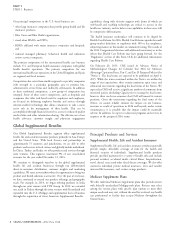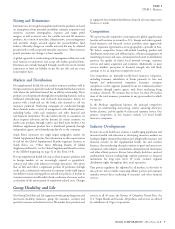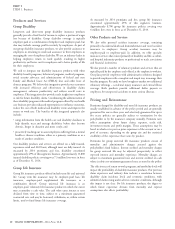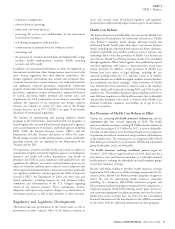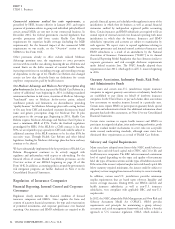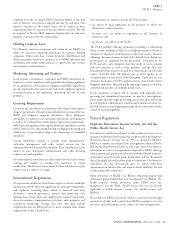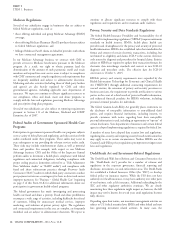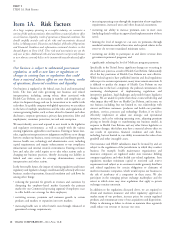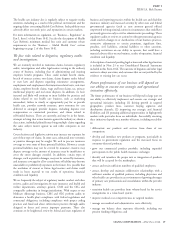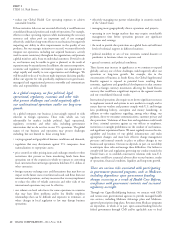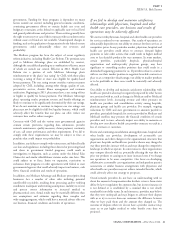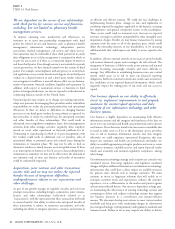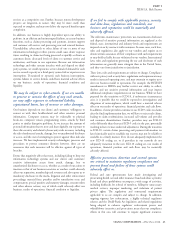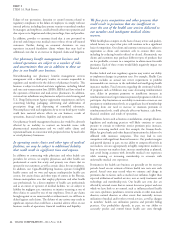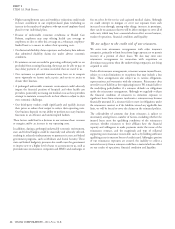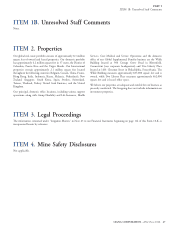Cigna 2014 Annual Report Download - page 50
Download and view the complete annual report
Please find page 50 of the 2014 Cigna annual report below. You can navigate through the pages in the report by either clicking on the pages listed below, or by using the keyword search tool below to find specific information within the annual report.PART I
ITEM 1A. Risk Factors
increasing operating costs through the imposition of new regulatory
requirements, increased taxes and other financial assessments;
Risk Factors
restricting our ability to increase premium rates to meet costs
As a large company operating in a complex industry, we encounter a
(including denial or delays in approval and implementation of those
variety of risks and uncertainties that could have a material adverse effect
rates);
on our business, liquidity, results of operations or financial condition. You
should carefully consider each of the risks and uncertainties discussed limiting the level of margin we can earn on premiums through
below, in Management’s Discussion and Analysis of Results of Operations mandated minimum medical loss ratios and required rebates in the
and Financial Condition and information contained elsewhere in this event we do not meet mandated minimum ratios;
Annual Report on Form 10-K. These risks and uncertainties are not the
restricting our ability to participate in and derive revenue from
only ones we face. Additional risks and uncertainties not presently known
government-sponsored programs; and
to us or that we currently believe to be immaterial may also adversely affect
us. significantly reducing the level of Medicare program payments.
Specifically, in the United States, significant changes are occurring in
Our business is subject to substantial government
the health care system as a result of Health Care Reform. Substantially
regulation, as well as new laws or regulations or
all of the key provisions of Health Care Reform are now effective.
changes in existing laws or regulations that could
While federal agencies have published interim and final regulations
have a material adverse effect on our business, results
with respect to certain requirements, many issues remain uncertain. It
of operations, financial condition and liquidity.
is difficult to predict the impact of Health Care Reform on our
business due to the law’s complexity, the political environment, the
Our business is regulated at the federal, state, local and international continuing development of implementing regulations and
levels. The laws and rules governing our business and related interpretive guidance, legal challenges and possible future legislative
interpretations, including, among others, those associated with changes. We are unable to predict how these events will develop and
Health Care Reform, are increasing in number and complexity, are what impact they will have on Health Care Reform, and in turn, on
subject to frequent change and can be inconsistent or in conflict with our business including, but not limited to, our relationships with
each other. As a public company with global operations, we are subject current and future customers, producers and health care providers,
to the laws of multiple jurisdictions and the rules and regulations of products, services, processes and technology. Further, if we fail to
various governing bodies, such as those related to financial and other effectively implement or adjust our strategic and operational
disclosures, corporate governance, privacy, data protection, labor and initiatives, such as by reducing operating costs, adjusting premium
employment, consumer protection, tax and anti-corruption. pricing or benefit design or transforming our business model, in
We must identify, assess and respond to new trends in the legislative response to Health Care Reform and any other future legislative or
and regulatory environment, as well as comply with the various regulatory changes, this failure may have a material adverse effect on
existing regulations applicable to our business. Existing or future laws, our results of operations, financial condition and cash flows,
rules, regulatory interpretations or judgments could force us to change including, but not limited to, our ability to maintain the value of our
how we conduct our business, restrict revenue and enrollment growth, goodwill and other intangible assets.
increase health care, technology and administrative costs, including Our insurance and HMO subsidiaries must be licensed by and are
capital requirements, and require enhancements to our compliance subject to the regulations of the jurisdictions in which they conduct
infrastructure and internal controls environment. Existing or future business. For example, health maintenance organizations and
laws and rules also could require us to take other actions such as insurance companies are regulated under state insurance holding
changing our business practices, thereby increasing our liability in company regulations and other health care-related regulations. State
federal and state courts for coverage determinations, contract regulations mandate minimum capital or restricted cash reserve
interpretation and other actions. requirements and subject us to assessments under guaranty fund laws
In the foreseeable future, the impact of existing regulations and future and related regulations for certain obligations to claimants of
regulatory and legislative changes could materially adversely affect our insolvent insurance companies, which would expose our business to
business, results of operations, financial condition and cash flows by, the risk of insolvency of a competitor in these states. We also
among other things: participate in the emerging private exchange marketplace and the
extent to which states may issue regulations that apply to private
reducing the potential for growth in revenues and customers by exchanges remains uncertain.
disrupting the employer-based market (currently the primary
market for our Commercial operating segment) if employers cease In addition to the regulations discussed above, we are required to
to offer health care coverage for their employees; obtain and maintain insurance and other regulatory approvals to
market many of our products, increase prices for certain regulated
restricting revenue, premium and customer growth in certain products and consummate some of our acquisitions and dispositions.
products and markets or expansion into new markets; Delays in obtaining or failure to obtain or maintain these approvals
increasing health care or other benefit costs through enhanced or could reduce our revenue or increase our costs.
guaranteed coverage requirements;
18 CIGNA CORPORATION - 2014 Form 10-K
•
Item 1A.
•
•
•
•
•
•
•


